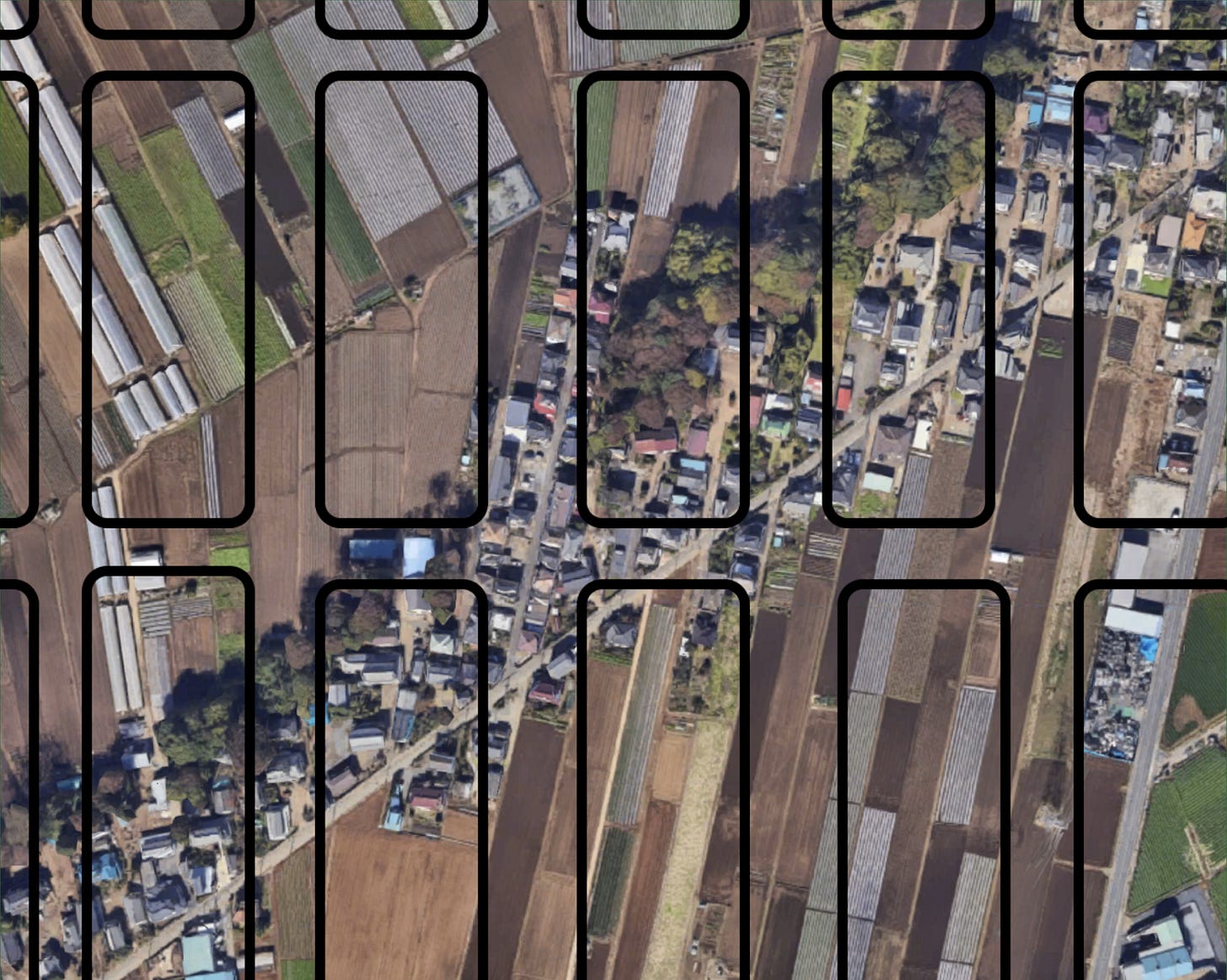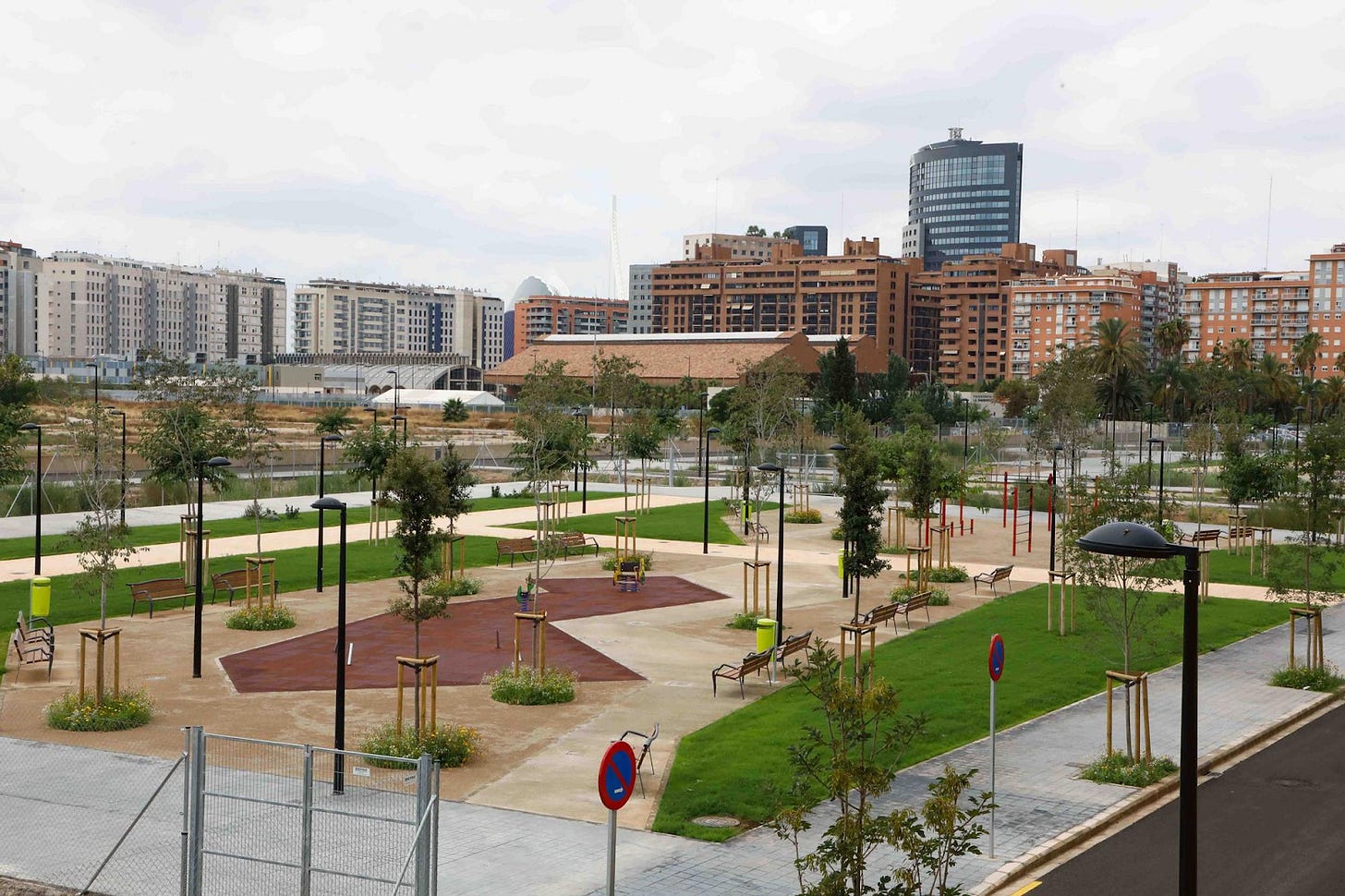Quick note: We’re starting a regular Progress Ireland happy hour on the last Thursday of each month, upstairs in The Duke, between 5.30 and 7.30pm. Come along for a chat with us, and others, about policy and Ireland.
Spanish cities are well known for their beauty and organisation. The paving is good, there’s a buzz on street corners. They have superb infrastructure, both roads and metros.
There’s much to be learned from Spanish urbanism, especially from an Irish perspective. How does Spain succeed at building these kinds of neighbourhoods where Ireland fails? Part of the answer is land readjustment.
Principles for success
Let’s briefly discuss how land readjustment works. It allows landowners to pool their holdings and redraw their land plots into a shape more suitable for urban development. Some land is also given up for infrastructure and other public uses like parks.
The left hand image above shows land holdings before land readjustment. They’re irregular in shape and would be difficult and inefficient in a more urban context. The roads are likewise all over the place, and there are no public spaces.
Land readjustment turns these messy land parcels into the right hand image: a regular set of parcels that are much more suitable for an urban setting. The roads are now laid out more consistently, and there’s a park. All of this makes the area much more attractive for increased development, whether for commercial, residential, or mixed purposes.
The letters on each diagram show how each landowner will receive a new plot of land after the adjustment. It won’t have the same boundaries as before, and some land will have been given up for the roads and the park, but overall the new land will be more valuable because it’s suitable for urban purposes.
To take another example, the image below shows how a real agricultural land pattern could be replotted into a grid structure:

Land readjustment has been implemented in countries as diverse as Japan, Germany, and Israel. Though the precise process in each jurisdiction differs, there are a series of common features.
First, landowner consent is an important aspect of land readjustment. Before any changes take place to ownership or boundaries, a vote is taken on the proposal. A supermajority (well over 50 per cent) required for the readjustment to proceed. If that threshold isn’t reached, nothing happens. Consensus is essential to land readjustment as it involves dramatic changes to an area. A sizable majority in favour of change means that legal and political challenges to the scheme, which could otherwise leave it unviable, will be limited.
Second, the drawing of land boundaries, otherwise known as replotting. As we saw in the diagram above, land is best laid out in grid structures within urban areas. Replotting agricultural land parcels into this grid structure means that the original owners won’t own the exact same parcel as before (especially after some land is used for public infrastructure).
Third, value capture and sharing. Landowners are incentivised to participate in land readjustment through the opportunity to sell (or otherwise develop) the land they receive at the end. This land will be more valuable than the old land, allowing landowners to make a profit.
At the same time, the infrastructure built during land readjustment must also be paid for. It’s part of what is providing the increase in land value. So at least some of the difference between the original land value and the new land value must be “captured” in order to pay for the new infrastructure, while still giving the landowner an incentive to vote for the readjustment.
Why land readjustment initially failed in Spain
On paper, Spain should have an extensive history with land readjustment. Legislation facilitating land readjustment, known as Reparcelación, has been on the books at the national level since 1956. One might have expected a boom in land readjustment projects to follow.
Not so. Unlike the Japanese, who have a steady track record with land readjustment, the mechanism didn’t work in Spain. An important reason for this was that landowners themselves were responsible for making a plan for the area, and figuring out how land could be assembled and redistributed among themselves.
That’s a problem because it requires a lot of work by individual landowners. They have to find their neighbouring landowners and draw up a plan that they’d be willing to endorse. In some areas, it might not even be obvious who owns which exact pieces of land. Even if this is well known, those owners might be hard to negotiate with or even unwilling to participate under any circumstances. There was no pressure for any landowner to engage in the process, even if some neighbours were trying to do it.
In economics, transaction costs refer to the time, money, or other costs associated with a purchase. If you’re buying a house, for example, legal fees are a form of transaction cost. You have to pay them to complete the purchase, but they’re not part of the underlying house itself, and you don’t get them back at the end.
The problem with landowner-led land readjustment is that it creates large transaction costs. If a landowner wants to kick off land readjustment in their area, they have to negotiate with every affected neighbour. Unsurprisingly, in Spain’s case, this meant that the mechanism didn’t really work.
Initial reform came in the mid-1970s through a national level law. As well as devolving the land readjustment power to the regional governments, the law introduced the role of an ‘urbanising agent’. This role could be filled by either a public land-development agency or private company.
The agent was to have two key responsibilities: creating the infrastructure for the new land plots, and fairly redistributing the land. This addressed the transaction costs faced by landowners when negotiating among themselves. Now, another actor in the system took on that job.
Challenges remained, however. Although landowners negotiated with the agent rather than their neighbours, the agent was in a weak negotiating position. There was a limit to how good a deal they could offer each landowner (there are only so many choice plots in the plan for each area). Landowners could simply hold out and demand a better deal, or take their chances without land readjustment at all.
Even if the Spanish government wanted to force a land sale for the sake of the public good, there was no available cash to compensate the landowner with. Land readjustment requires relatively little cash to compensate owners because their reward is a new land plot. Requiring a lot of cash compensation rendered land readjustment unviable. No one really used the tool for the next two decades.
Valencia’s solution
The region of Valencia was the first to solve this problem in 1994. The most important reform it introduced that year was adding the possibility of forced land readjustment. This new backstop meant that landowners could no longer negotiate indefinitely. Instead the urbanising agent could, in principle, get government approval for a compulsory land readjustment if landowners didn’t cooperate.
The urbanising agent could now negotiate with greater confidence, knowing that the state could back them up if needed. At the same time, landowners could no longer delay a readjustment indefinitely, preventing their neighbours from realising the true potential value of their land.
The results of this law in Valencia were striking. The process of selecting an urbanising agent went from 3-5 years to 3-7 months. The average time to deliver serviced building plots from site election to completion fell to under three years. The number of development sites increased more than fivefold from around 40 per year to 221 in 1997. Frustratingly, the region stopped collecting data at this point, but academic observers note that ‘[a]side from the 1994 Act, no other external variables can explain the significant increase in investments.’
In other words, getting the incentives right meant that land readjustment could really take off. Most other regions in Spain have now copied Valencia’s 1994 reforms.
Following Spain’s lead
Valencia’s reforms allowed it to develop areas like Camino hondo del Grao, with 500 new homes and 7 square kilometres of green public space.

Zorrozaurre in Bilbao offers another example that’s currently underway. This 2.5km peninsula was full of industrial activity in the 1960s, facilitated by an uncompleted canal that gave access to the Port of Bilbao. However, economic problems in the 1970s led to industrial decline, and businesses and residents left. Urban decay set in.

An urban regeneration project has now begun, however, and the area was masterplanned by the late Zaha Hadid. As part of this, the canal has already been completed, turning the area into an island. The 208 separate land plots were subject to land readjustment, which will allow the development of a mix of office and residential neighbourhoods. The area plan achieves density while maintaining lots of public spaces.

Spain’s success emphasises two lessons for a successful land readjustment policy.
First, it’s important to create an entity which can minimise the transaction costs involved in land readjustment. Negotiation takes time, so it’s no surprise that landowners don’t want to do that among themselves. An outside entity with specific responsibilities, and financial incentives, to complete landowner negotiations means a plan can be made in a reasonable time frame.
Second, compulsory action is an essential backstop to negotiations. Landowners always face the option to simply wait out negotiators and see if their land value changes for some other reason. It’s therefore important that land readjustment offers a stick as well as a carrot. Intransigence and delay can be solved through compulsory purchase of the land.
Ireland already has a tool for this, Compulsory Purchase Orders (CPOs). They’ve been around for over a century, and are due for reform. The Law Reform Commission’s report and draft bill will streamline the process if adopted by the government.
The experience of other countries can save Ireland time by showing how to do land readjustment well. We should learn from them and the decades they’ve spent getting it right.







